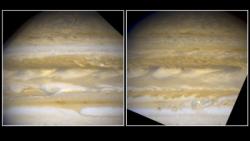The Hubble Space Telescope photographed the massive planet Jupiter at moments of atmospheric change - it happened quickly and unexpectedly

Storms on Jupiter as imaged in 2007 by Hubble.
Dramatic changes in the atmosphere of the planet Jupiter
Photo: Hubble Space Telescope.
We experience many changes in the weather on Earth, one day the sky is cloudy and the next day the sky is clear of them. This is how it happens in the other planets, it just changes according to times. The Hubble Space Telescope photographed the planet Jupiter at the moment of the atmospheric change - it happened quickly and unexpectedly.
The clouds on the planet Jupiter change quickly when there are always atmospheric encounters, any disturbance in the encounter can lead to a huge storm that will pass over the ground at a speed of hundreds of kilometers per hour. The photograph from the Hubble Space Telescope reveals changes in the shape and colors of the clouds close to the equator. One picture before the change and a second picture after. The first photo was taken on March 25th of this year, and the second photo was taken on June 5th of this year, the time span between the photos shows how the entire strip changes its colors.
Areas where the atmosphere rises are called "zones" - areas; And where the atmosphere falls, they are called "belts". Over a period of three and a half months, many of the zones changed to belts, and vice versa.
Astronomers had seen the climatic changes before Hubble's images, using telescopes from Earth, but never before had the changes been seen in such detail as in the image. Hubble's photographs will help astronomers to more accurately predict weather changes on the planet Jupiter, and may also help in finding an explanation for how giant storms occur, such as the previously recorded anticyclonic storm - the Great Red Spot.
Translation: Yariv Zerbiv.
To the original article on the Hubble Space Telescope website

One response
Please correct: range